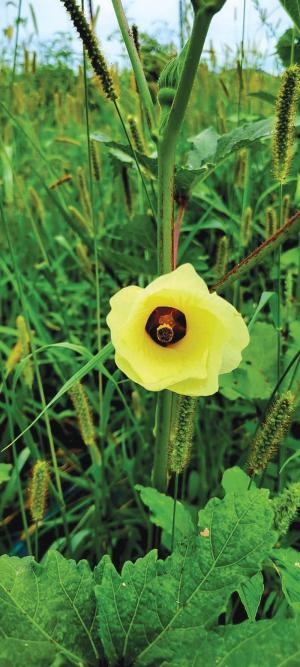Northern Gardeners Can Plant Okra, Too
 ✖  |
If you want something new to grow in your garden this year, consider adding okra to your seed list. Jeffrey Miller has proven that the popular southern food can be grown in northern gardens. However, convincing his North Dakota neighbors to try okra has been a little more difficult.
“It’s an acquired taste,” he says, noting he became interested in okra when he traveled with his work as a geologist and tasted good fried okra at a Virginia restaurant. He enjoys it fried, baked, pickled and raw.
Paying $8 for a small jar of pickled okra inspired him to grow the plant, typically grown in the South, in his half-acre garden.
“Okra is the last thing I plant in early June to make sure the ground is warm,” he says, noting that black woven landscape fabric is also helpful. He cuts a slit to expose a 3 in. width of soil to plant seeds 1/4 in. deep every 8 or 10 in.
Still, germination is challenging, and it can take three weeks before plants appear. However, they thrive in hot weather and can grow up to 6 ft. tall on sturdy stalks similar to sunflowers.
Okra is actually a hibiscus that blooms with yellow flowers in August. By the middle of the month, the okra pods start to mature, and Miller harvests them about every other day when they’re about 4 to 6 in. long.
“They go from tender to wood, and you can’t chew it,” he says, noting that he often samples raw okra in the garden to make sure it’s still good with a fresh green flavor. To ensure continued harvest, he also picks over-mature pods that he feeds his chickens. Plants produce until the temperature drops to 32 F.
Miller has tried several varieties and has had success with Clemson Spineless, which is less prickly than some. Cow Horn okra is an heirloom that produces longer pods and has a good flavor.
He likes to try different varieties, but he notes that the weather is the biggest factor in success.
“Every year, you have things that do better than others. So, the more diversification you have, the better,” he says. For example, plants like okra and peppers don’t do as well in cool summers.
When it’s hot and they do well, Miller sells his surplus harvest through his Facebook page, where he also sells other garden bounties, Aronia and elderberries. So far, his only interest in okra is from people who have moved from the South to North Dakota.
In addition to eating it fresh, Miller freezes okra to bake, fry and add to soups during the winter. He also pickles and cans many quarts.
Okra’s reputation for being slimy is true, he admits, especially when it’s pickled or in soups. But when fried or baked correctly, okra is something northerners and Midwesterners may want to try.
Contact: FARM SHOW Followup, Jeffrey Miller, 5447 E. River Rd., Kindred, N.D. 58051 (ph 701-371-1060; jeffreydmiller@hotmail.com; Facebook: Cottonwood Bend Farm)

Click here to download page story appeared in.
Click here to read entire issue
Northern Gardeners Can Plant Okra Too CROPS New Techniques If you want something new to grow in your garden this year consider adding okra to your seed list Jeffrey Miller has proven that the popular southern food can be grown in northern gardens However convincing his North Dakota neighbors to try okra has been a little more difficult “It’s an acquired taste ” he says noting he became interested in okra when he traveled with his work as a geologist and tasted good fried okra at a Virginia restaurant He enjoys it fried baked pickled and raw Paying $8 for a small jar of pickled okra inspired him to grow the plant typically grown in the South in his half-acre garden “Okra is the last thing I plant in early June to make sure the ground is warm ” he says noting that black woven landscape fabric is also helpful He cuts a slit to expose a 3 in width of soil to plant seeds 1/4 in deep every 8 or 10 in Still germination is challenging and it can take three weeks before plants appear However they thrive in hot weather and can grow up to 6 ft tall on sturdy stalks similar to sunflowers Okra is actually a hibiscus that blooms with yellow flowers in August By the middle of the month the okra pods start to mature and Miller harvests them about every other day when they’re about 4 to 6 in long “They go from tender to wood and you can’t chew it ” he says noting that he often samples raw okra in the garden to make sure it’s still good with a fresh green flavor To ensure continued harvest he also picks over-mature pods that he feeds his chickens Plants produce until the temperature drops to 32 F Miller has tried several varieties and has had success with Clemson Spineless which is less prickly than some Cow Horn okra is an heirloom that produces longer pods and has a good flavor He likes to try different varieties but he notes that the weather is the biggest factor in success “Every year you have things that do better than others So the more diversification you have the better ” he says For example plants like okra and peppers don’t do as well in cool summers When it’s hot and they do well Miller sells his surplus harvest through his Facebook page where he also sells other garden bounties Aronia and elderberries So far his only interest in okra is from people who have moved from the South to North Dakota In addition to eating it fresh Miller freezes okra to bake fry and add to soups during the winter He also pickles and cans many quarts Okra’s reputation for being slimy is true he admits especially when it’s pickled or in soups But when fried or baked correctly okra is something northerners and Midwesterners may want to try Contact: FARM SHOW Followup Jeffrey Miller 5447 E River Rd Kindred N D 58051 ph 701-371-1060; jeffreydmiller@hotmail com; Facebook: Cottonwood Bend Farm
To read the rest of this story, download this issue below or click
here to register with your account number.







